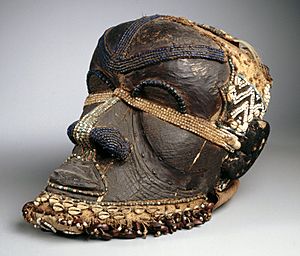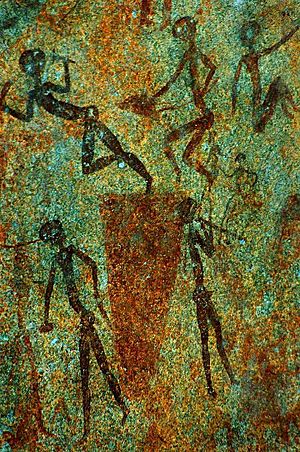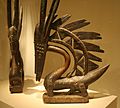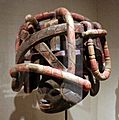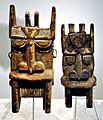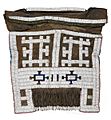African art facts for kids

African art is any kind of art or handmade items that come from the continent of Africa. This article mainly talks about visual art, which is art you can see. If you want to learn about African music, check out Music of Africa.
Contents
What Makes African Art Special?
- Made for Use: A big part of traditional African art is that it's not just for looking at; it's meant to be used! Many everyday items were beautifully decorated and used regularly.
- Creative Styles: Unlike some other places where art follows strict rules, many African societies encouraged artists to be super creative with their styles and forms. This has been a common theme across Africa for a very long time.
- Abstract Look: African artworks often look less like real life and more abstract. This means they show ideas or feelings rather than trying to look exactly like something. They might use shapes, colors, or forms to represent things in a unique way.

- Focus on Sculpture: African artists often preferred three-dimensional artworks, like statues, over flat paintings. Even some paintings or cloth works were designed to be experienced in a 3D way.
- Art in Performance: Many African artworks, especially masks and costumes, were made to be used in performances. People would "dance" these masks in community ceremonies. Each mask often had a special name that included its meaning, the dance it was used in, and the spirits connected to it. In African thinking, these parts couldn't be separated.
- Many Meanings: Symbols and shapes in African art often had different meanings for different people in society. This is different from some other cultures where a symbol usually has only one main meaning.
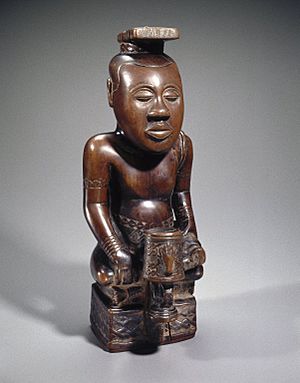
A Look at African Art History
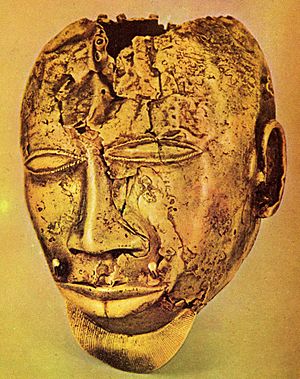
African art began a very long time ago, even before written history! For example, ancient rock art in the Sahara desert in Niger shows carvings that are 6,000 years old. Art from western tribes, the Egyptian area, and southern indigenous crafts all added to the rich history of African art. This early art often showed animals, plants, or abstract designs. Abstract art uses colors and shapes creatively, not always showing things exactly as they look in real life.
How African Art Inspired Western Art
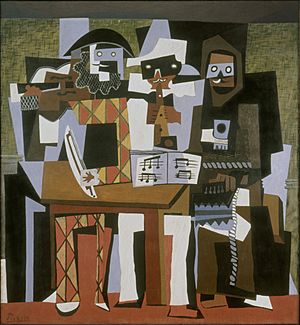
In the 1900s, famous abstract artists like Picasso, Matisse, and Modigliani were greatly inspired by abstract African sculptures. They were looking for new ways to express themselves through art. The Cubist art movement, for example, studied traditional African masks. They saw these masks not just as cultural items, but as amazing works of art in their own right.
Traditional African Art Forms
Traditional art includes the most well-known forms of African art, often found in museums. Wooden masks, which can look like humans or animals, are very common in West Africa. These ceremonial masks were originally used by actors and dancers in performances.
Masks are often made with materials like Ivory, animal hair, plant fibers (like raffia), and natural colors (like kaolin). They might also include stones and semi-precious gems. Statues, usually made of wood or ivory, are often decorated with cowrie shells, metal studs, and sometimes even nails.

Decorated clothing is also a big part of African art. One of the most detailed African fabrics is the colorful, strip-woven Kente cloth from Ghana.
Art Styles by Country
Côte d'Ivoire
The Baoulé, Senoufo, and Dan peoples of Côte d'Ivoire are very skilled at carving wood. Each culture creates many different wooden masks. The people of Côte d'Ivoire use masks to represent animals, gods, or the spirits of those who have passed away.
Because these masks are believed to hold spiritual power, only specially trained people are allowed to wear or own certain ones. Each ceremonial mask is thought to have a soul or life force. Wearing these masks is believed to transform the wearer into the person or spirit the mask represents.
Botswana
In northern Botswana, women in the villages of Etsha and Gumare are famous for their amazing baskets. They make them from Mokola Palm and local dyes. These baskets come in three main types: large, lidded baskets for storage; big, open baskets for carrying things on the head or for checking grain; and smaller baskets for checking pounded grain.
The art of making these baskets is getting even better with new colors and designs. This is partly because they are now made to be sold to others.
The oldest known ancient paintings in Africa come from Botswana and South Africa. These paintings, made by the Khoisan people (who are native to southern Africa), show animals and humans hunting. They were created before written history began.
Egypt
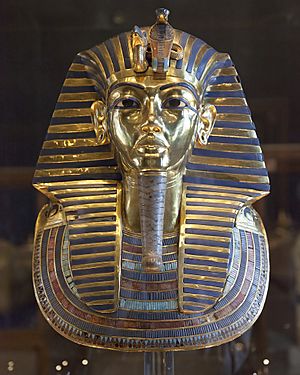
For 3,000 years and many ruling families, Egypt's official art focused on the state religion. This art included huge stone statues, small figures, and wall paintings that showed history and myths. Much of ancient Egypt's art looks very formal, with figures standing straight and stiff, like royalty. This perfect look was probably used to show how god-like the rulers were.
The smooth and realistic way human forms were shown in Egyptian art of this time was better than art in Greece, which sometimes had less accurate body shapes.
Quick Facts About African Art
- African art started before written history.
- Most African art was made to be used in daily life, not just for beauty.
- Much African art (except Egyptian art) didn't try to show things exactly as they looked. It was more abstract.
- African art often had more than one meaning, and different viewers might see different things in it.
- Some African art was made to be used in performances, like dances.
- Masks were believed to have life and power, so only trained people could wear them.
Images for kids
-
Fest für Neptun, sculpture on the outside areas of the building of the Deutsche Welle (Schürmann-Bau) in Bonn
-
Two Bambara Chiwara c. late 19th early 20th centuries, Art Institute of Chicago. Female (left) and male Vertical styles
-
Bobo Mask (Nyanga) from Burkina Faso, made in the early 19th century. Brooklyn Museum
-
Bet Maryam church, Lalibela. Traditional Ethiopian church art
-
Modern Makonde carving in ebony
-
Nok seated figure; 5th century BC – 5th century AD; terracotta; 38 cm (1 ft. 3 in.); Musée du quai Branly (Paris). In this Nok work, the head is dramatically larger than the body supporting it, yet the figure possesses elegant details and a powerful focus. The neat protrusion from the chin represents a beard. Necklaces from a cone around the neck and keep the focus on the face.
-
Relief fragment with heads and figures; 5th century BC – 5th century AD; length: 50 cm (19.6 in.), height: 54 cm (21.2 in.), width: 50 cm (19.6 in.); terracotta; Musée du quai Branly. As most African art styles, the Nok style focuses mainly on people, rarely on animals. All of the Nok statues are very stylized and similar in that they have this triangular shape eye with a perforated pupil, with arched eyebrows.
-
Male head; 550–50 BC; terracotta; Brooklyn Museum (New York City, USA). The mouth of this head is slightly open. It maybe suggests speech, that the figure has something to tell us. This is a figure that seems to be in the midst of a conversation. The eyes and the eyebrows suggest an inner calm or an inner serenity.
-
Male figure; terracotta; Detroit Institute of Art (Michigan, USA)
-
Maiden spirit mask; early 20th century; wood & pigment; Brooklyn Museum (New York City, USA)
-
A mask known as the Queen of Women (Eze Nwanyi); late 19th-early 20th century; wood & pigment; Birmingham Museum of Art (Alabama, USA)
-
Bronze ornamental staff head; 9th century; Igbo-Ukwu; Nigerian National Museum
-
Bronze head from Ife; 12th–15th century; brass; British Museum (London)
-
Gelede mask; circa 1900–1915; Detroit Institute of Arts (USA)
-
Pair of door panels and a lintel; circa 1910–1914; by Olowe of Ise; (British Museum, London)
-
Carved door; circa 1920–1940; wood with iron staples; by Nupe people; Hood Museum of Art (Hanover, New Hampshire, USA)
-
Headdress; early 1900s; wood, antelope skin, basketry, cane, metal; by Ejagham people; Cleveland Museum of Art (USA)
-
Otobo (hippopotamus) mask; by Kalabari people; British Museum (London)
-
Stool; possibly late 19th to early 20th century; wood & pigment; National Museum of African Art (Washington D.C., USA)
-
Black and white picture of a female figure with raised arm; 15th–17th century; wood (ficus, moraceae), sacrificial materials; height: 44.8 cm (175⁄8 in.); by the Tellem people; Metropolitan Museum of Art (New York City)
-
Zoomorphic figurine; 12th-16th century; by Tennenkou culture; Museo de Arte Africano Arellano Alonso (Valladolid, Spain)
-
Figurine of a standing woman; late 19th or early 20th century; wood; 27.9 × 8.3 × 10.2 cm (11 × 31⁄4 × 4 in.); Brooklyn Museum (New York City)
-
Kifwebe mask; wood; Royal Museum for Central Africa (Tervuren, Belgium)
-
Antropomorphic figurine; terracotta; 9th-16th century; Musée du quai Branly (Paris)
-
Head; terracotta; Muséum d'Histoire naturelle de La Rochelle (La Rochelle, France)
-
Murals in the Ndebele from the Maastricht University (the Netherlands)
-
A beaded apron or meputo; late 19th-early 20th century; hide, glass beads, metal beads, straw; 46.9 × 50.8 cm (18.5 × 20 in.); Birmingham Museum of Art (Alabama, USA)
-
Both sides of the Narmer Palette; circa 3100 BC; greywacke; height: 63 cm (243⁄4 in.); from Hierakonpolis (Egypt); Egyptian Museum (Cairo). The Narmer palette is the quintessential statement of the Egyptians' mythology of kingship. A clear manifesto of royal power, it is also one with multiple layers of symbolism
-
The Bust of Nefertiti; 1352-1336 BC; limestone, plaster & paint; height: 48 cm (197⁄8 in.); from Amarna (Egypt); Egyptian Museum of Berlin (Germany). Perhaps the most iconic image of a woman from the ancient world, the bust of Nefertiti is difficult to contextualize because it seems so exceptional
See also
 In Spanish: Arte africano para niños
In Spanish: Arte africano para niños


